Interior Layout
[ Floor Plan |
Original Interior |
Heating |
Toilet |
Parcels Van |
Luggage Racks |
Cycle Racks |
Refurbishment ]
Interior Layout |
|
|
[ Floor Plan |
Original Interior |
Heating |
Toilet |
Parcels Van |
Luggage Racks |
Cycle Racks |
Refurbishment ]
| |
Class 156s units are formed of two carriages designated
Driving Motor Standard (A) and (B)
The trains are standard class throughout and have seats arranged in twos either side of a centre aisle. In each carriage there are 10 bays with seats around a table, with the remaining seats arranged face-to-back. The external doors are at each end of the carriage, with manual sliding doors separating the vestibules from the passenger saloon. | |
Floor plan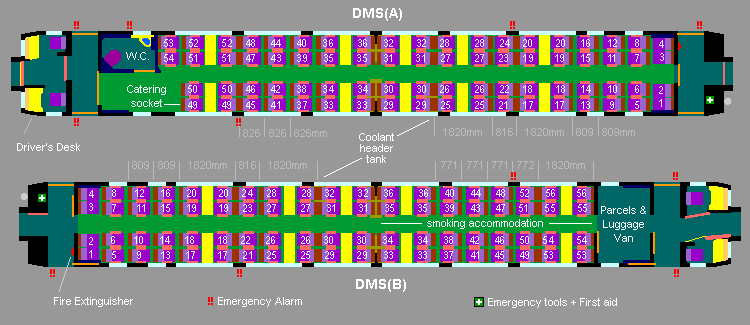 When the class 156s vehicles were still under-construction the seating capacity for the 2-car train was quoted as 163. This included 5 tip-down seats in the DMS(A) opposite the toilet which were never fitted, and the parcels van in the DMS(B) included hinged bench seats (as fitted to class 150 units) which were to seat 4 passengers on each side. These were only fitted to the earliest trains and were soon removed. The 24 seats nearest the parcels van were originally designated as smoking accommodation and provided with ashtrays mounted in the seat backs. From 1995 operators of class 156 units have each adopted non-smoking policies, and the trains are now non-smoking throughout. All Units now carry an on board wheelchair ramp. Those refurbished for Northern Spirit (now Arriva Trains Northern) have this stored opposite the toilet. On other units it is stored in place of an emergency equipment cupboard; on ScotRail and North Western units it is in the DMS(B) vehicle, whereas on Central trains is can be found in the DMS(A) vehicle. |
|
The photo below shows the interior of newly delivered 156.402 in February 1988 (the aisle carpet still has a protective covering.) | |
 Photo: Paul Stanforth |
In the original colour scheme, the side walls were painted cream, and the end walls and seat units were beige. The inner end of the passenger saloon had orange diagonals either side of the doorway. Seat covers were mid grey, with a bold red chevron pattern down the center. Aisle carpets were a red and grey zig-zag pattern, and the area from below the window down to the heating duct was covered with grey cloth. Original seat design was the Ashbourne type used on many multiple units ordered by British Rail in the late 1980's. Fold down armrests are fitted and the face-to-back seats feature a fold down tray with cup-holder. In the designated smoking area there are ashtrays on the seat backs. |
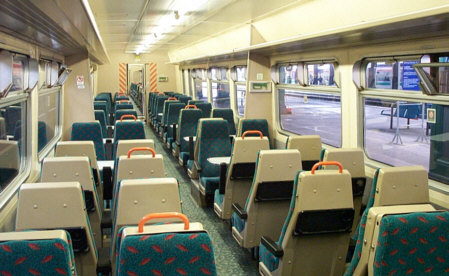
| Interior view of a Strathclyde 156 with new carpet and seat covers in 2001. Lighting is provided by a single row of bare fluorescent tubes. The large windows have pairs of opening hoppers at the top for ventilation. |
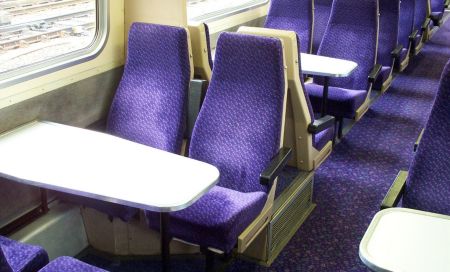
|
A heating and ventilation unit is mounted under the centre of the carriage, and from here the air is blown through floor level ducts along the sides of the saloon. The grille by the aisle is an intake for recirculating air. The engine coolant header tank is also located between a pair of seat backs near the centre of the coach. |
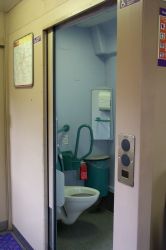  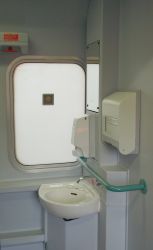
|
The toilet compartment in the DMS(A), is located at the driving end and has special features for disabled persons, although not compliant with the 1998 Rail Vehicle Accessibility Regulations. It has an air-powered sliding door, hand rails and low level emergency alarms (often mistaken for the flush!). Porterbrook owned 156s have had restyled toilets fitted at refurbishment. |

| Lockable parcels vanIn the 1980's both Royal Mail and Red Star parcels were carried on passenger trains, and Provincial's new DMU's were provided with secure compartments for this traffic.The 156s have a compartment at the driving end of the DMS(B) with a lockable sliding door.
|
Compared to the locomotive hauled coaching stock they replaced, provision of space for luggage was rather limited. In 1989 Norwich depot undertook some modifications to unit 156.419 to improve matters. Seats 1 and 2 in the DMS(A) vehicle were replaced by a luggage stack, and a secure parcels shelf was fitted in the van area of the DMS(B). Soon afterwards all the Norwich units were modified in this way. | |
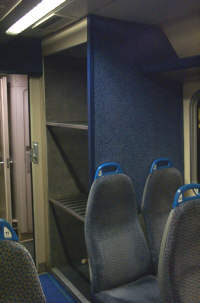 
|
On the right is a full height luggage rack fitted in place of seats 1 and 2 in the DMS(A) car. On the left is a secure parcels shelf fitted on one side of the van area in the DMS(B) car. The units originally based at Norwich Crown Point depot, are now shared between One, Central Trains and Northern. |
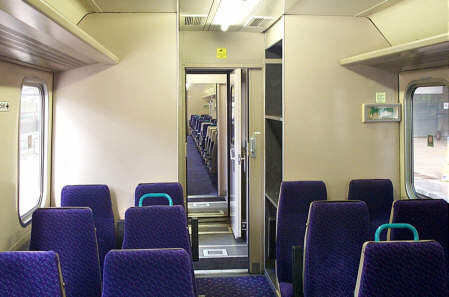
| During the early 1990's most of the ScotRail fleet was fitted with extra luggage space. These full height luggage stacks replace seats 1, 2, 3 and 4, which behind the door pockets, had no arm rests and the poorest view from the train. |
A further modification to some of the units that worked on the West Highland line was the replacement of seats 53 and 54 in the toilet fitted vehicle with these extra luggage stacks. The following ScotRail units have this feature: The 18 units of the former North Western fleet also had similar racks fitted during refurbishment.
156.420,421,423,424,425,426,427,428,429, | 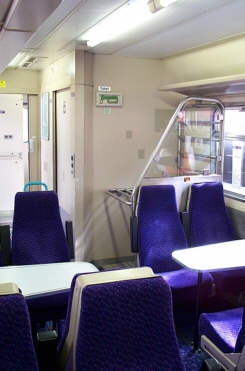
|
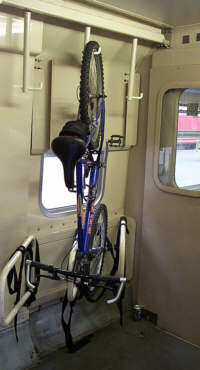 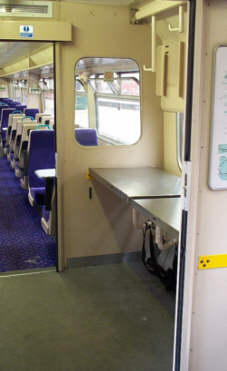 |
During 1998 ScotRail increased the bicycle carrying capacity of it's units to six by fitting cycle racks in the luggage van. This meant removal of the secure parcels shelves that had previously been fitted to some of the units. One side of the van features fold down shelves, for when the cycle racks aren't needed. Strathclyde PTE paid for the remainder of the Corkerhill based units to be fitted in 2001. |
Interior refurbishment of the class started in 1995 with an prototype scheme carried out by Tickford Rail on ScotRail operated unit.
All 114 units have now been refurbished to some degree - only the Scottish based units retain the original 'Ashbourne' seating - and all have been repainted in new liveries.